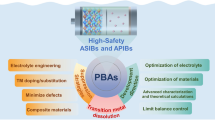Abstract
The molten salt electrochemical method is an efficient one-step process to extract tungsten from tungsten carbide (WC). Owing to the limitation of molten salt electrochemical experiments and the number of data points, determining the optimal process conditions is challenging. In addition, the mechanism that affects the current efficiency is difficult to obtain intuitively. In this study, simulations of tungsten carbide anode electrolysis were obtained using the COMSOL Multiphysics 5.3, and the results were compared to the dissolution experiment of tungsten carbide with varying content of sodium tungstate (Fig. 1). The experimental data fitted well with the theoretical current efficiency of 75%. At concentrations below 0.5 wt% of sodium tungstate, the anode dissolution showed a linear relationship against the concentration of sodium tungstate. At a constant concentration of sodium tungstate, the anodic dissolution decreased with increasing immersion depth, consistent with the variation of cell voltage difference before and after electrolysis. The optimal immersion depth and effective area of the anode estimated by simulations were 2.5 mm and 0.465 mm2, respectively (Fig. 2). Under the optimum electrolysis conditions simulated by COMSOL, the nano tungsten powder was obtained.
Graphic abstract











Similar content being viewed by others
References
Zhang LW, Nie ZR, Xi XL, Ma LW, Xiao XJ, Li M (2018) Electrochemical dissolution of tungsten carbide in NaCl-KCl-Na2WO4 molten salt. Metall Mater Trans B 49(1):334
Zhang LW, Nie ZR, Xi XL, Ma LW (2018) Electrochemical separation and extraction of cobalt and tungsten from cemented scrap. Sep Purif Technol 195:244
Si GH, Xi XL, Nie ZR, Zhang LW, Ma LW (2016) Preparation and characterization of tungsten nanopowders from WC scrap in molten salts. Int J Refract Met Hard Mater 54:422
Xi XL, Si GH, Nie ZR, Ma LW (2015) Electrochemical behavior of tungsten ions from WC scrap dissolution in a chloride melt. Electrochim Acta 184:233
Xiao XJ, Xi XL, Nie ZR, Zhang LW, Ma LW (2017) Direct electrochemical preparation of cobalt, tungsten, and tungsten carbide from cemented carbide scrap. Metall Mater Trans B 48(1):692
Zhang QH, Xi XL, Nie ZR, Zhang LW, Ma LW (2019) Electrochemical dissolution of cemented carbide scrap and electrochemical preparation of tungsten and cobalt metals. Int J Refract Met Hard Mater 79:145
Li M, Xi X, Liu Q, Nie Z, Ma L (2019) Direct electrolytic separation of tungsten and cobalt from waste cemented carbide and electrochemical behavior of tungsten and cobalt ions in NaF–KF molten salts. J Electroanal Chem 833:480
Zhao HC, Lu HM (2009) The analog simulation of three-layer electrolysis cell for refining of aluminum. In: Tms 2009 138th Annual Meeting & Exhibition—Supplemental Proceedings, vol 3. General Paper Selections, p 825
Shao CL, He AX, Zhang ZY, Zhou JF (2019) Study on the transition process of a molten salt pump transporting media with crystalline particles by modeling test and numerical simulation. Int J Numer Method Heat Fluid Flow 29(9):3263
Podila K, Chen Q, Rao YF (2019) CFD simulations of molten salt reactor experiment core. Nucl Sci Eng 193(12):1379
Qiao G, Alexiadis A, Ding YL (2017) Simulation study of anomalous thermal properties of molten nitrate salt. Powder Technol 314:660
Betzler BR, Heidet F, Feng B, Rabiti C, Sofu T, Brown NR (2019) Modeling and simulation functional needs for molten salt reactor licensing. Nucl Eng Des 355:110308
Gheribi AE, Chartrand P (2016) Thermal conductivity of molten salt mixtures: theoretical model supported by equilibrium molecular dynamics simulations. J Chem Phys 144(8):084506
Diao J, Fan G, Liu X, Xie B (2014) Computer simulation of anionic structures of molten CaO-SiO2-P2O5 system. Metall Mater Trans B 45(5):1942
Li Q, Li M, Kuang S, Zou Z (2015) Numerical simulation of the interaction between supersonic oxygen jets and molten slag-metal bath in steelmaking BOF process. Metall Mater Trans B 46(3):1494
Mirgaux O, Ablitzer D, Waz E (2009) Mathematical modeling and computer simulation of molten aluminum purification by flotation in stirred reactor. Metall Mater Trans B 40(3):363
Vatamanu J, Borodin O, Smith GD (2010) Molecular dynamics simulations of atomically flat and nanoporous electrodes with a molten salt electrolyte. Phys Chem Chem Phys 12(45):15136
Fei T, Feng B, Heidet F (2020) Molten salt reactor core simulation with PROTEUS. Ann Nucl Energy 140:107099
Li J, Zhang XY, Liu YB, Li YG, Liu RP (2013) Electrochemical behavior of tungsten in (NaCl-KCl-NaF-WO3) molten salt. Rare Met 32(5):512
Gao H, Jin X, Zou S, Ling F, Peng J, Wang Z, Chen GZ (2013) Liquid diffusion of the instantaneously released oxygen ion in the electrolytic porous Fe from solid Fe2O3 in molten CaCl2. Electrochim Acta 107:261
Acknowledgements
This work was supported by Beijing Natural Science Foundation (Grant No: 2204073) and National Natural Science Foundation of China (Grant No: 51621003).
Author information
Authors and Affiliations
Corresponding author
Additional information
Publisher's Note
Springer Nature remains neutral with regard to jurisdictional claims in published maps and institutional affiliations.
Rights and permissions
About this article
Cite this article
Zhang, Lw., Xi, Xl., Nie, Zr. et al. Simulation analysis on optimization of tungsten carbide recovery efficiency by molten salt electrolysis. J Appl Electrochem 51, 861–870 (2021). https://doi.org/10.1007/s10800-021-01536-2
Received:
Accepted:
Published:
Issue Date:
DOI: https://doi.org/10.1007/s10800-021-01536-2




